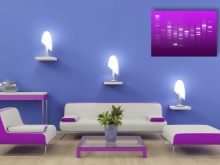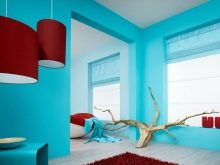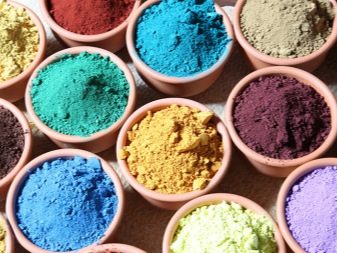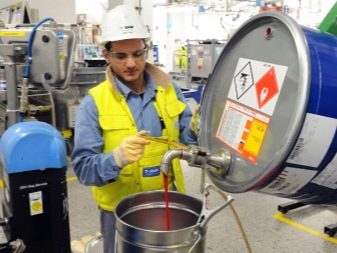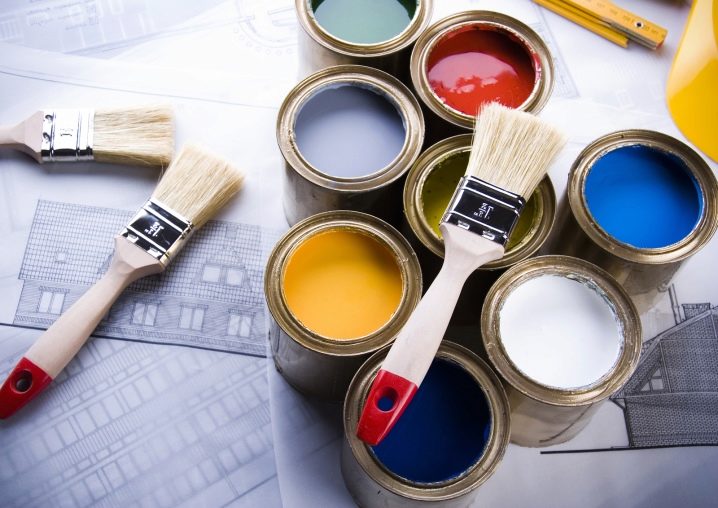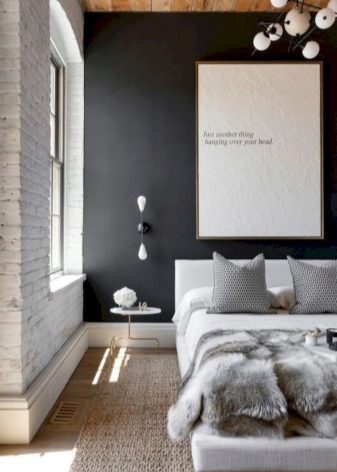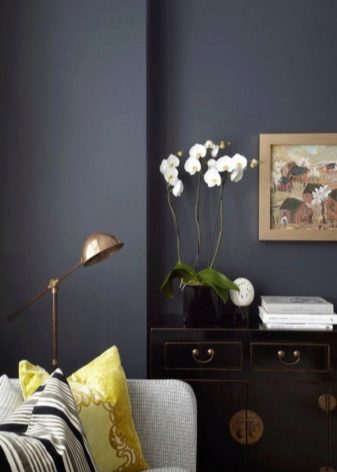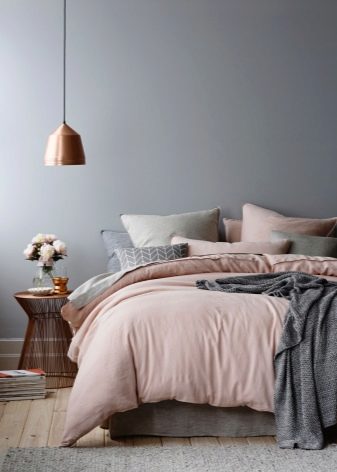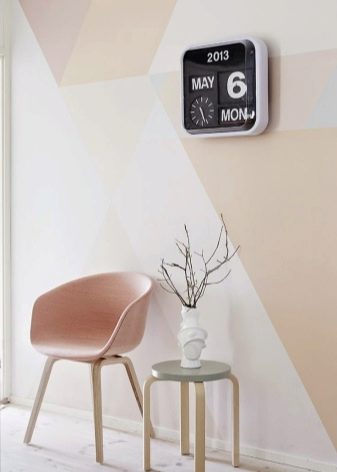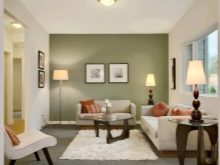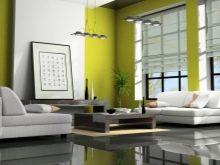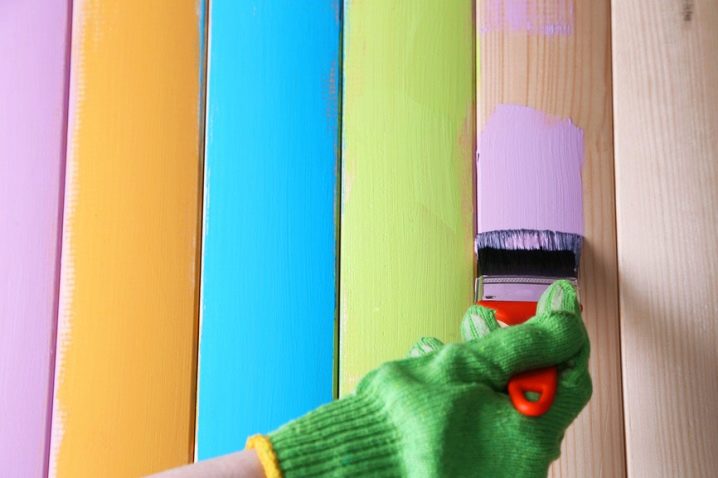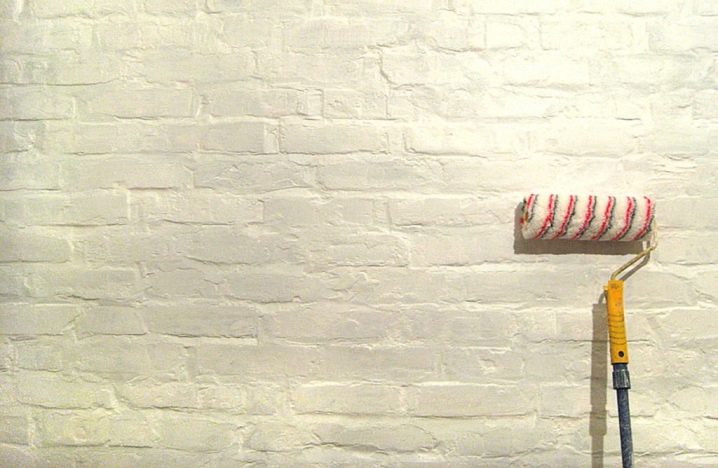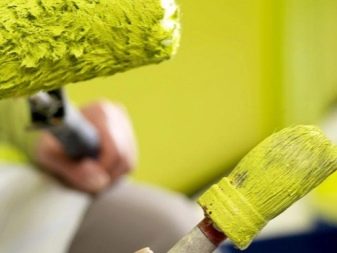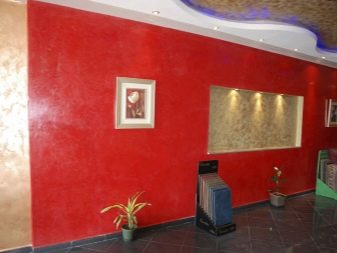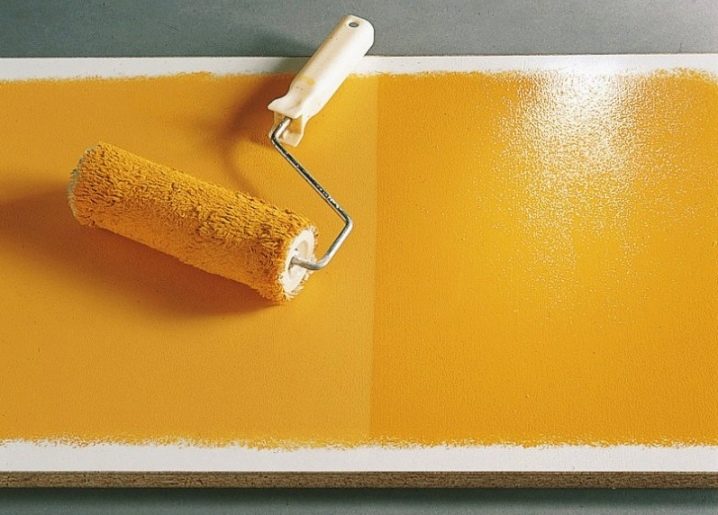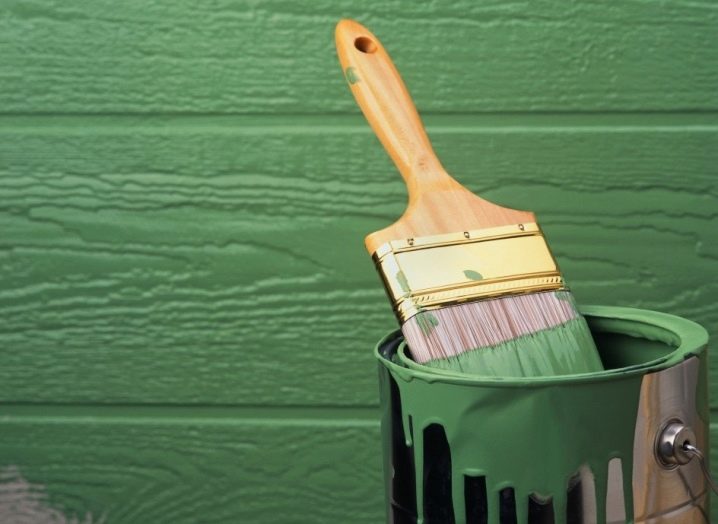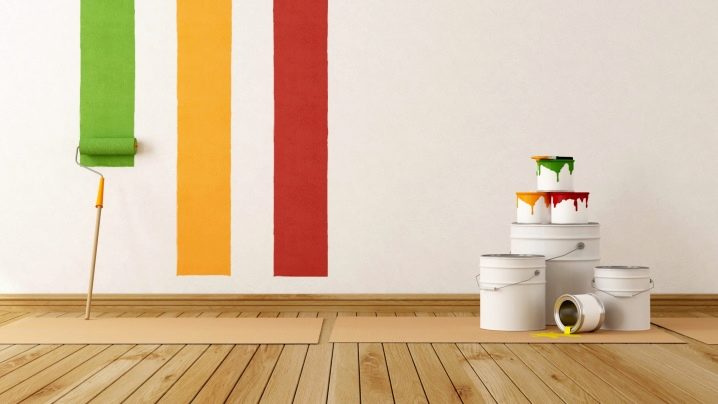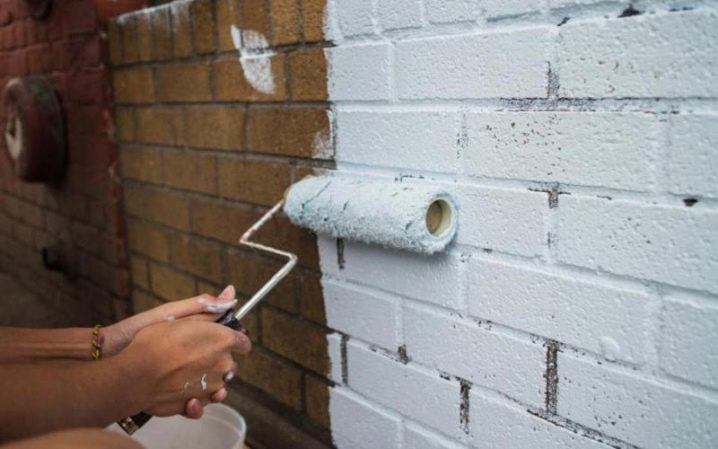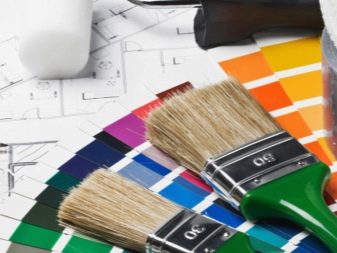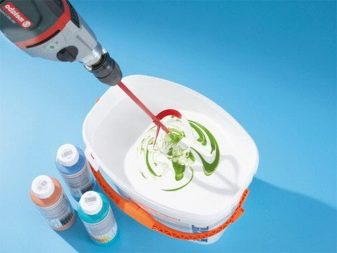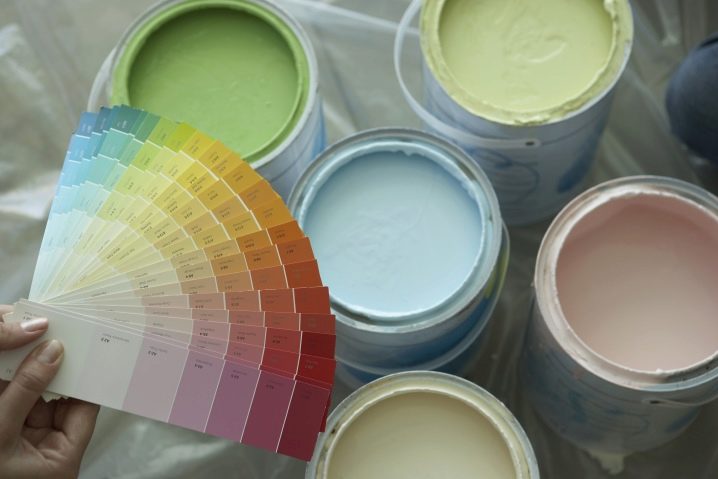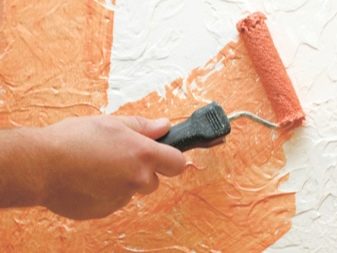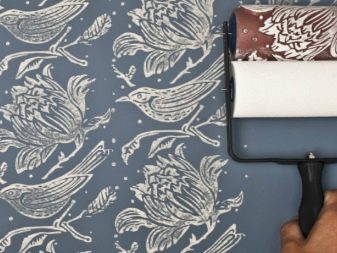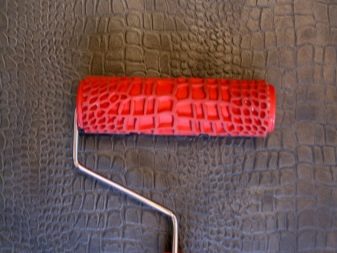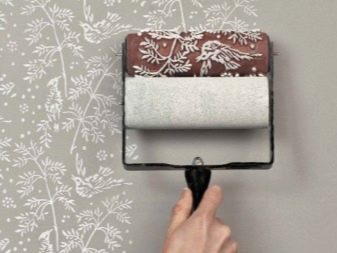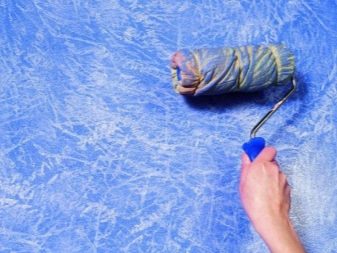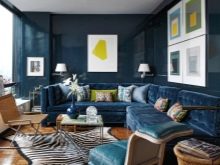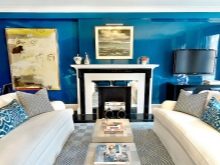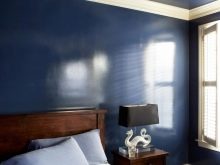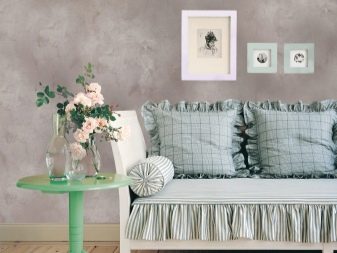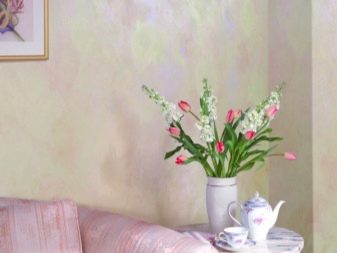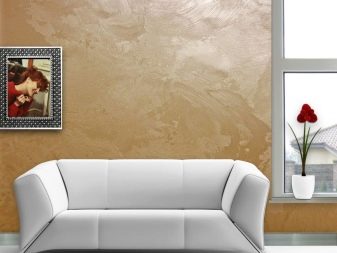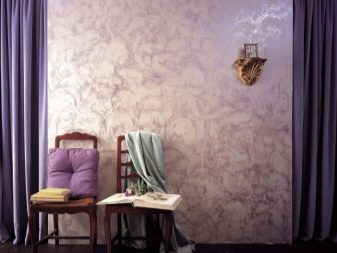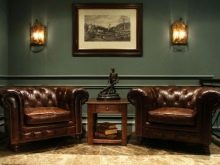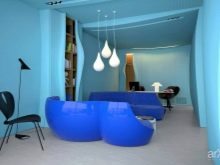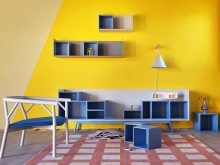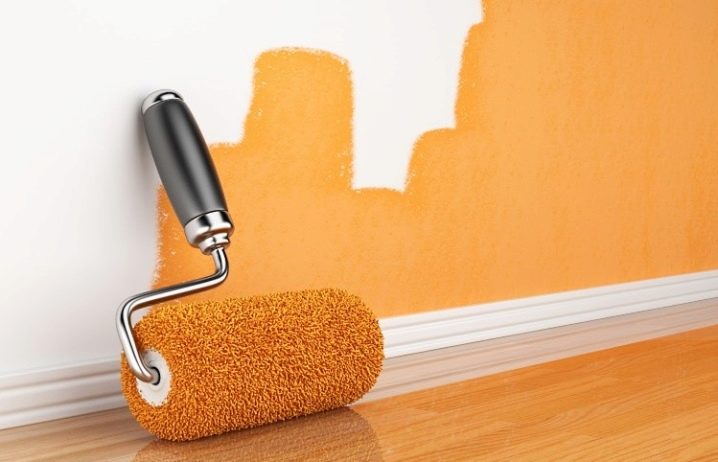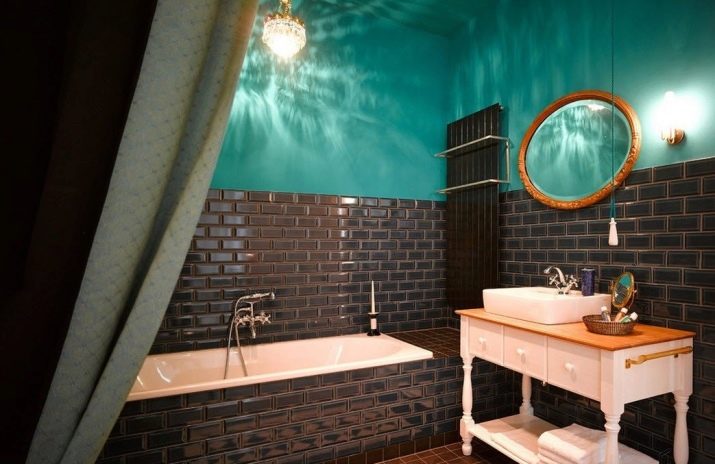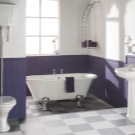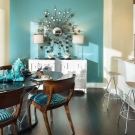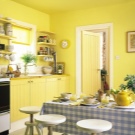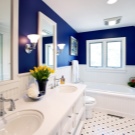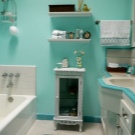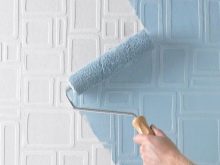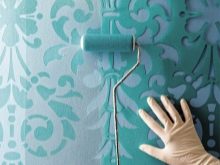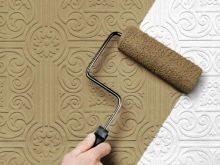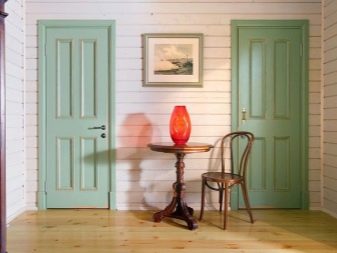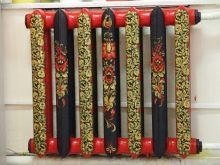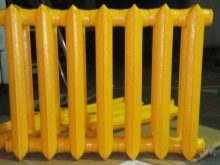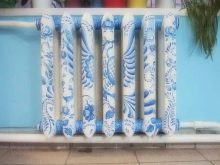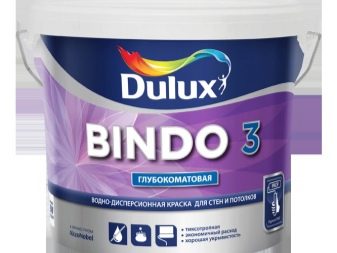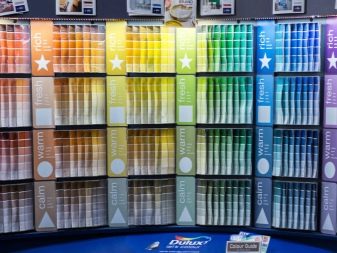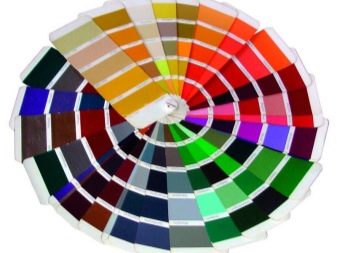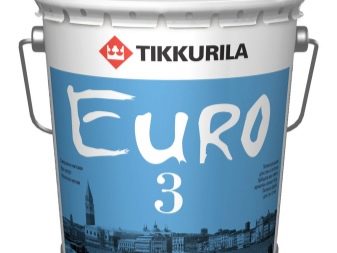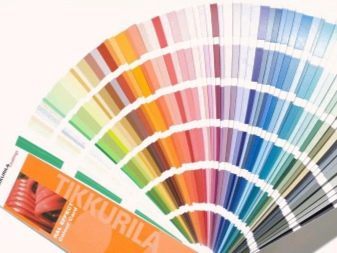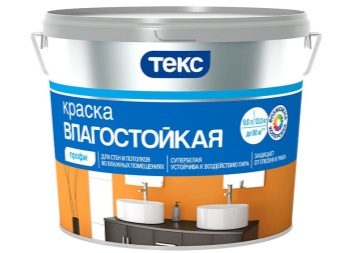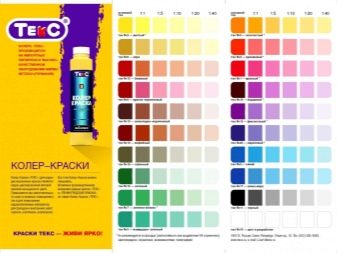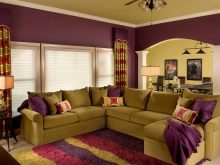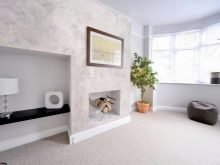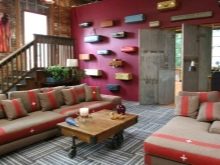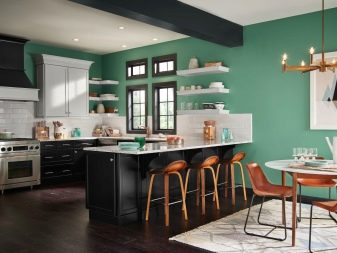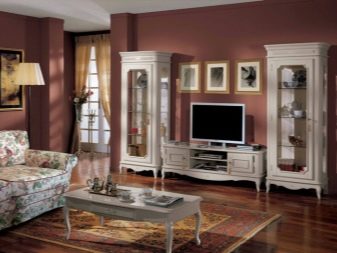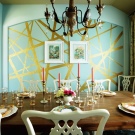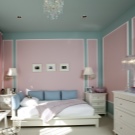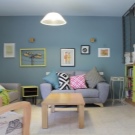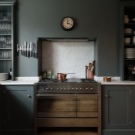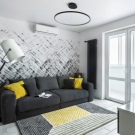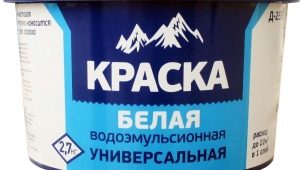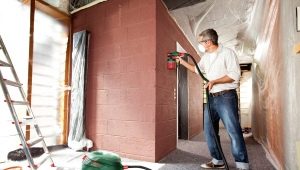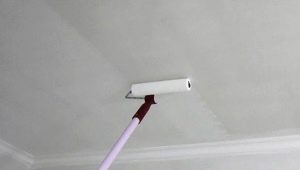Emulsion paint: the pros and cons
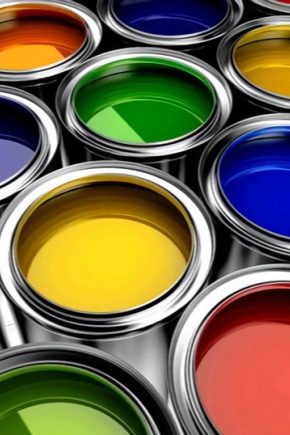
Today, a large amount of materials can be used to complete the interior finish. Popular is water-based paint, which is characterized by many positive characteristics inherent in not all types of coloring compositions.
This material shows good adhesion, a variety of species, a fairly simple application. Care of the painted surface does not require special skills and equipment. But it is important to be able to choose the right paint for repair.
Special features
The aqueous emulsion ink contains fillers and polymers (sometimes latex), which are in water. In addition, an adhesive emulsion is added, due to which adhesion of the composition becomes possible, and last of all - a pigment that gives the paint a basic color sound.
Initially, the paint components do not dissolve in water, so its production is carried out in several stages:
- adding pigments and polymers to water;
- grinding (dispersing) the components of the composition;
- introduction of other additives using a special mixer (dissolver).
After that, the paint is considered finished, it is packaged and sent to the shops. In this case, the proportions of certain substances in the compositions of different manufacturers will be different.
It is thanks to the component features of the paint and got its name. An emulsion is a dispersed system. This composition is characterized by the presence of a mixture of microscopic droplets of two non-dissolving liquids. As a rule, it is water and polymers.
Other name of paint - water dispersion, because it is based on aqueous dispersions of polymers. They, in turn, contain suspensions of fillers and pigments, auxiliary additives (emulsifiers, stabilizers). Aqueous emulsion paint does not contain organic solvents, which explains its environmental safety, non-toxicity.
Advantages and disadvantages
Aqueous emulsion paint has several advantages, among which the most significant are:
- Ecological composition. It is caused by the absence of organic solvents.Therefore, the paint is suitable for application in institutions for children.
- Non-toxic. This paint does not smell when applied and during drying.
- Fire and explosion safety, which are explained by the characteristics of the paint.
- Low abrasion.
- Resistance to corrosive media, including alkalis.
- Moisture resistance allows such coatings to be subjected to wet cleaning.
- Gas and vapor permeability ensures the maintenance of the microclimate in the room, the absence of the effect of "steam room".
- Compatible with most surfaces.
- Price availability.
- Ease of application.
- Long shelf life - 24 months. However, only the paint for which the conditions prescribed by the manufacturer are created is stored as much.
As well as any material, paint on a water dispersive basis has "minuses":
- Exposure to bacteria, fungi, mold, which actively proliferate when applying paint in damp, inadequately heated rooms. In this case, the problem can be solved by pre-cleansing the wall from mold and fungus, its treatment with special compounds. When choosing a water-based paint for such rooms, preference should be given to compounds with antibacterial and antifungal effects.
- This composition is not suitable for unheated rooms and exterior work, because at low temperatures the painted surface is covered with cracks.
- The impossibility of applying the composition to surfaces covered with adhesive composition and varnish, as well as metals. However, if necessary, cover the metal parts with a “water emulsion”, the latter are primed in several layers. After that, the paint perfectly lays down and keeps on the metals.
Types and characteristics
The composition of water-dispersion paints can vary the presence of certain additives. This, in turn, affects the technical properties of the paint: its appearance, scope, application features.
There are the following types of interior "water emulsion":
- Polyvinyl acetate. The basis of this composition is a polyvinyl acetate emulsion, which is a very white dense homogeneous substance. It is also the basis of PVA glue. It happens plasticized (it is frozen at 0 degrees, it is afraid of frost) and unplasticized (it can withstand up to 4 freezing cycles). Plasticizers and stabilizers are added to the polyvinyl acetate emulsion.As for the coloring pigments, they may be present or absent. The content and ratio of the components of the composition, as well as the production processes are regulated by GOST 28196 89. After being applied to the surface, water evaporates from the emulsion, and the remaining substances harden, acquiring hydrophobic characteristics. After drying, a porous semi-matt surface is formed. The period of solidification at a temperature of +22 - 2-3 hours.
The popularity of this type of coating is due to good hiding performance (the parameter of the decorative characteristics of the coating that affects color properties and gloss), the possibility of painting porous surfaces (brick, concrete, plaster, cardboard), getting a strong and attractive film, high drying rate.
You can get the right shade by buying the right color paint. or adding color to white paint. In the latter case, it is recommended to apply at least 2 layers of “water-based emulsion” in order to get a good result. Finally, it is worth noting the minimum price of polyvinyl acetate paint compared with other types of water-dispersion formulations.
At the same time, the paint is not suitable for rooms with high humidity. When applied to the surface of chalk, clay, limestone, metal paint begins to peel off, and with excessive mechanical stress - to crack.
- Acrylic. The main components of acrylic paint are water-dispersion mixture and polyacrylates. It is the presence of the latter that provides increased moisture resistance of the paint; it is also called “washable” and is suitable for rooms with a high level of humidity. At the same time, the painted layer is characterized by vapor permeability, under it does not form molds and fungi. Due to its good elasticity, the paint is suitable for applying not only on walls, but also on the ceiling. At the same time, it demonstrates compatibility with almost all types of working bases, including metal ones. The latter types are necessarily pre-grounded. Due to its resistance to UV and abrasion, painted surfaces retain a presentable appearance and brightness of a shade even when exposed to direct sunlight and with regular wet cleaning.
- Latex paint - This is a common name for several types of "water emulsion", which include latex. This additive may be present in acrylic, acrylic-silicone, acrylic polyvinyl acetate and acrylic butadiene-styrene paints. The main feature of compositions containing latex is the ability to form a special "crystalline" surface structure, which acquires the properties of high moisture resistance and resistance to aggressive media, including alkaline ones. The finished coating is characterized by a higher density than other types of "water-based emulsion".
Depending on the appearance of the painted surfaces, and more precisely the gloss / haze indicators, the latex "water emulsion" can be of the following types:
- highly matt (CM 0-5);
- semi-matte (MP 11-29);
- matte (M 6-10);
- highly glossy (SG 90-100);
- glossy (D 60-89);
- semi-glossy (PG 30-59).
To achieve a particular effect on a painted surface, it is important to pay attention to the indicated characteristics of the latex compositions. So, for example, when applying paint over wallpaper, matte will accentuate the texture of the latter, while the glossy will blur it, distract from the features of the texture.Latex paints have all the "advantages" of water-dispersion compositions, but at the same time they have greater strength and resistance to abrasion. However, latex paint should be used only in heated premises, because otherwise its quality deteriorates.
- Silicate Aqueous emulsion paint consists of a water dispersion, liquid glass and color pigments. It has all the qualities inherent in water-based paints (environmental friendliness, breathability, fire and explosion safety). In addition, painted surfaces have high moisture resistance and retain their properties for a long time. The life of such paint - up to 20-25 years. The presence of special additives prevents contamination of stained bases with mold and fungus.
- Feature of the composition of silicone products is presence of silicone resin. Due to this, paint can be used on most surfaces. Among other advantages is the possibility of covering surfaces with small (up to 2 mm in width) cracks. After drying, all defects disappear, forming a smooth surface.The paint can be used in rooms with high humidity and even applied on semi-moist bases. Due to high vapor permeability it is possible to avoid the formation of mold on the painted surface and fungal formations. It is important that the characteristics of opacity also at a height - for an optimal result of dyeing just one coat of paint is enough.
The painted surface does not attract dirt, so its cleaning is rarely required. Naturally, such technical qualities cause a higher cost of the product.
- The main components of the mineral paint are cement and slaked lime, thanks to which the paint fits well on brick, cement and concrete surfaces. If polyvinyl acetate emulsion is present in the composition of the mineral enamel, then the dried surface will be resistant to the effects of fats and refined products. A significant "minus" of mineral compounds is a short lifetime.
Colors and design
Among the advantages of water-based paint color diversity is noted.However, more and more often, white or transparent paint can be found on store shelves. A small vial of color is purchased for them - a composition saturated with pigment, which, when added to the “water emulsion”, gives it the desired shade. The use of liquid colors allows you to get complex colors that are not on sale. In addition, by changing the concentration of color in the paint, you can achieve a gradation effect when painting the surface. In other words, it will be possible to change the intensity of the color from more saturated to restrained.
Today, experts recommend abandoning ready-made solutions. and take advantage of colors. This is due to the fact that in the production of colored paint, a single shade is obtained, the equipment is not able to display tones or semitones. As a result of dyeing with finished compositions, the degree of illumination of the working bases and their material are not taken into account. That is why dried surfaces can lose volume, and the room itself can become dark and small.
But if it is necessary to use achromatic black, gray colors, it is better not to waste time on tinting, but to purchase a ready-made composition.
When tinting water-based paint should adhere to the following recommendations:
- Select the ratio of components should be in the room where the staining will be performed. In this case, first preparing a test batch, which is painted a small area. All proportions are recorded. After drying, the result is evaluated in daylight and electric lighting. If you are satisfied with the result, proceed to the preparation of paint and paint the entire surface.
- When adding color to the paint can not be poured the contents of the bottle immediately. It is better to do this in small portions, literally drop by drop, regularly mixing the composition. This will achieve the desired intensity of the finished product.
- You should prepare the entire volume of paint at once, otherwise in the future (when tinting in small portions) you risk not finding a similar shade. Of course, if the work surfaces are large and the whole process takes a long time (the paint starts to harden in the bucket), then this recommendation is irrelevant. In this case, you need to carefully fix the used proportions of paint and color scheme and monitor their compliance with subsequent preparations of the composition.
Please note that you can tint only white paint. In the presence of yellowish and other pigments in it, the result of staining is unpredictable.
The decor of the surfaces painted with “water-emulsion” in most cases is achieved not through paint, but through the use of various materials and techniques for applying the composition. It is quite popular to apply paint on decorative plaster. In this case, the first layer is applied to the dried plastered surface with a base color. It is important that the coloring composition fills all the recesses and projections of the surface; coloring with the spray gun usually helps to achieve this. The next layer (of a different or the same shade as the base one, but more intense) is applied with a sponge or bald roller.
A crumpled newspaper or a damp cloth allows you to get relief or abstract stains. To do this, blot the painted and uncharged surface with a piece of newspaper or cloth, after crushing them. An unusual effect is the application of paint textured roller. It has a certain pattern on its surface that is transferred to the area to be decorated.When choosing this method should be borne in mind that the paint consumption will increase.
In addition to the use of special tools and improvised tools, you can choose special acrylic paints that provide the desired decorative effect. To obtain the texture, it is better to purchase acrylic, silicone, silicate or mineral versions of water-dispersion paints. The composition of the paint may be quartz crumb or other natural filler. The result of staining will be unusual visual effects, a sense of volume, imitation of various surfaces. The painted surface turns out uneven, relief, reminding rock. To imitate the surface of wood or cork marsell wax is used. After drying, the surface is covered with a special wax.
For rooms with high humidity and surfaces requiring frequent wet cleaning is recommended to use a glossy water-based paint. In addition, it allows you to achieve brilliant smooth surfaces, while more “calm” matte paint has a porous structure that attracts pollution.Painting the ceiling with a glossy composition allows you to visually “lift” them, to increase the area of the room. But if the indoor ceiling height is about 3 m, the glossy coating is lost, and it looks inexpressive. Glossy paint gives a strong mirror effect.
An interesting result can be obtained using pearlescent composition. Its peculiarity is that with different incidence of light, the surface exhibits many shades within the same color palette. In other words, volume is achieved, the versatility of color. Refraction of color is possible due to the introduction of the smallest mother-of-pearl color in the paint.
Scope of application
With its many advantages, interior water-based paint loses them when applied to exterior surfaces. That is why such compositions are suitable exclusively for interior work. "Water emulsion" suitable for decoration of walls and ceilings not only in residential, but also office and industrial premises. At the same time for the ceiling it is better to choose a special paint, it will have a thicker, more convenient for distribution, texture.
Due to environmental friendliness and non-toxicity, “water-based” is actively used for surface decoration in children's and medical institutions.Most water-dispersion compositions demonstrate good adhesion with the main types of working surfaces. When applied to some of them (for example, metals) their preliminary priming is required. The most versatile in terms of compatibility with working grounds is an acrylic product. When applied to porous surfaces, the glossiness / dullness of the paint is also important. For porous surfaces it is better to use glossy and semi-glossy options.
It is recommended to paint surfaces that are subject to frequent wet cleaning (in public places or in the kitchen) with latex compounds. Even after several years of active use, they retain vapor permeability, resistance to moisture and an attractive appearance. In rooms characterized by high humidity (kitchens, bathrooms, washing facilities and swimming pools, houses of old buildings), it is better to paint walls and ceilings with silicate compounds, and if there is a need to protect surfaces from mold and fungus, they should be silicone.
The ideal paint for wallpaper is latex. When applying other types of possible soaking wallpaper, a violation of their texture.And latex paint strengthens them, making possible wet cleaning of surfaces. To a greater extent it is suitable for non-woven, than for paper wallpaper. Moreover, the latter should be designed for painting.
If you need to paint the tree, then you should choose "water-based" with a special mark on the package. Such compositions not only fit perfectly on wooden surfaces, preserving their original texture, but also protect them from rotting, the effects of mold and fungus. For wood, only matte versions are used, because the gloss "eats" the natural beauty of the material.
Often there is a need to paint not the walls or the ceiling, but small elements. rooms, such as radiators. At the same time, the coloring composition applied to the battery must withstand high temperatures and protect the surface from corrosion. For these purposes, acrylic matte paint is optimal (gloss will draw attention to irregularities and defects in the coating). Do not forget that the paint should be designed for application to the battery, and it is better to paint it outside the heating season.
Manufacturers
Production of water-based paint is carried out both abroad and in Russia.Leading brands are:
- Dulux - British manufacturerspecializing in the production of building materials. Paint and varnish products are of the highest quality, and therefore a considerable price. You can buy Dulux paint in 1, 2.5, 5 and 10 l containers. The price for a container with a volume of 10 liters starts within 4500-5000 rubles. In this case, the paint consumption according to the manufacturer is 13-17 l / m2. The advantage is a wide range of products designed for different uses. There are many formulations for interior applications for universal use (Dulux Trade Diamond Matt, Dulux Trade Ecosure Matt, Dulux Trade Diamond Eggshell), for rooms with high humidity (Dulux Trade Supermatt) and for kitchens (Dulux Realife Kitchen Matt), as well as for surfaces, prone to frequent washing (Dulux Trade Vinyl Silk).
Of the unique compositions of the brand should be noted Dulux Trade Vinyl Soft Sheen (applied to the wallpaper for painting), Dulux Light & Space Matt (reflective material), Dulux Magic White (has a color indicator).
- Caparol - Paint German manufacturer, which is another leader in the global market. For the composition of the walls and ceiling volume of 5 liters will have to pay about 750 rubles. Moreover, the cost of paint affects its moisture resistance. The higher the last characteristic, the higher the price of the composition. Consumption averages 90-150 g / m2. There are also varieties of product that differ in scope.Interior paint can be universal (Caparol Alpina Matllatex, Caparol Malerit), for mold-prone surfaces (Caparol Fungitex-W), washable (Caparol Samtex 3 E.L.F.). For batteries and radiators manufacturer offers the composition of Caparol Alpina Heizkorperlack.
- Tikkurila - products of the Polish manufacturer, perhaps the most famous in Russia. This is due to the high quality of paint and its democratic price, a wide variation of the product and the richness of colors.
- Tex. The advantage of domestic paint "Tex" is the versatility of its application. It fits well on concrete, brick, plasterboard, wooden and plastered bases, there are compositions for wallpaper (glass, flizilinovyh). However, this paint is not suitable for application to surfaces that are subject to increased contamination. Increased whiteness of paint, cost efficiency and affordability - this is what causes the popularity of the material on the market of paints and varnishes.
Tips for choosing
When choosing a water-based composition, one should proceed from the type of surface on which it will be applied. For walls made of concrete, brick, wood, as well as plastered surfaces, acrylic paints with a latex component should be purchased.For the ceiling - acrylic, latex, acrylate compositions.
If it is assumed that the surface will be subjected to active abrasion, for example, the walls of the kitchen, the nursery, then it is better to apply glossy and semi-glossy versions. For the bathroom and other rooms where it is excessively wet, it is necessary to choose silicate, silicone (if there is a tendency to the formation of mold on surfaces) or latex paints. They have hydrophobic properties, good vapor permeability.
When buying, it is important to evaluate the following product specifications:
- The composition of the paint. If it contains organic solvents and phenol, you can safely conclude that it is not water-based paint, regardless of the seller’s beliefs.
- Paint consumption per 1 m2. The lower the coefficient, the more economical the flow rate and, accordingly, less composition will be required for painting the room. It should be remembered that the manufacturer indicates the paint consumption for ideal surfaces (plastered, perfectly smooth, when applying paint in one layer). If we talk about real consumption, then on average it is 150 g / m2 for single-layer application and 250 g / m2 for two-layer.
- Composition viscosity (that is, the ratio of water content and other elements in the paint). This indicator affects the choice of paint application tool. So, if you are going to paint the surface with a brush, the viscosity should be between 40-45. When applied by the spray gun, a composition with a viscosity index of 20-25 should be selected.
- Full drying time. It is important to understand here that the time range specified by the manufacturer (usually from 2 to 10 hours) is valid only if certain conditions are met (usually it is 22-25 ° C, air humidity is not more than 60%).
- The criterion for assessing quality should be the price. This "water-based", the main components of which are imported from Europe, can not be cheap. Price for 1 liter of paint on average starts from 100 p.
- Product weight Liter of water-dispersion composition ranges from 1.35-1.5 kg. That is, a 10-liter paint bucket cannot weigh less than 15 kg.
- Paint can only be bought in certified heated stores. When freezing the product loses its properties.
- For additional protection of the acrylic or other water-dispersion layer it can be varnished.For these purposes, using a universal varnish for interior work. In addition, varnish may be required to create a decorative texture of painted surfaces.
You will learn more information about the features of water-based paint in the following video.
